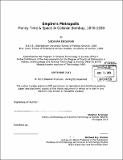| dc.contributor.advisor | Michael M.J. Fischer. | en_US |
| dc.contributor.author | Krishnan, Shekhar, Ph. D. Massachusetts Institute of Technology | en_US |
| dc.contributor.other | Massachusetts Institute of Technology. Program in Science, Technology and Society. | en_US |
| dc.coverage.spatial | a-ii--- | en_US |
| dc.date.accessioned | 2014-04-25T15:48:55Z | |
| dc.date.available | 2014-04-25T15:48:55Z | |
| dc.date.copyright | 2013 | en_US |
| dc.date.issued | 2013 | en_US |
| dc.identifier.uri | http://hdl.handle.net/1721.1/86283 | |
| dc.description | Thesis: Ph. D. in History, Anthropology, and Science, Technology and Society (HASTS), Massachusetts Institute of Technology, Program in Science, Technology and Society, 2013. | en_US |
| dc.description | Cataloged from PDF version of thesis. | en_US |
| dc.description | Includes bibliographical references. | en_US |
| dc.description.abstract | The thesis utilises newly available legal and municipal archives to study the historical geography of colonial Bombay through five interlocking themes and periods from 1870-1930. This spans the period between the boom and bust in the cotton trade during and after the American Civil War - when Bombay was a colonial mercantile port - to its emergence as of one of India and Asia's largest industrial cities after the First World War. Separate chapters explore the history of railway and telegraph networks, standardisation and time-keeping, land acquisition and valuation, cadastral surveying and property registration, and the urban built environment. From the perspective of the colonial city, the history of these formations looks less like the smooth unfolding of singular standards of money, time or space, than a protracted war of position fought out across a century by experts, elites and the masses. This thesis seeks to deepen the social and political history of urbanization in South Asia beyond concepts of colonial technology transfer or nationalist resistance by examining the everyday politics of stock and real estate speculation, public clocks, land and private property, maps and topographical surveys, and buildings and streets in colonial Bombay. These "modern" technologies of calculation, coordination and control in the urban environment both created and depended on new scales of power and capital accumulation, or particular configurations of industrial technologies, civic institutions and urban space. | en_US |
| dc.description.statementofresponsibility | by Shekhar Krishnan. | en_US |
| dc.format.extent | 291 pages | en_US |
| dc.language.iso | eng | en_US |
| dc.publisher | Massachusetts Institute of Technology | en_US |
| dc.rights | M.I.T. theses are protected by copyright. They may be viewed from this source for any purpose, but reproduction or distribution in any format is prohibited without written permission. See provided URL for inquiries about permission. | en_US |
| dc.rights.uri | http://dspace.mit.edu/handle/1721.1/7582 | en_US |
| dc.subject | Program in Science, Technology and Society. | en_US |
| dc.title | Empire's metropolis : money time & space in Colonial Bombay, 1870-1930 | en_US |
| dc.title.alternative | Money time and space in Colonial Bombay, 1870-1930 | en_US |
| dc.type | Thesis | en_US |
| dc.description.degree | Ph. D. in History, Anthropology, and Science, Technology and Society (HASTS) | en_US |
| dc.contributor.department | Massachusetts Institute of Technology. Program in Science, Technology and Society | |
| dc.identifier.oclc | 876040931 | en_US |
